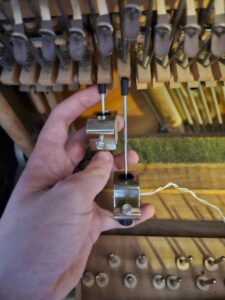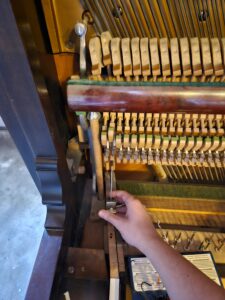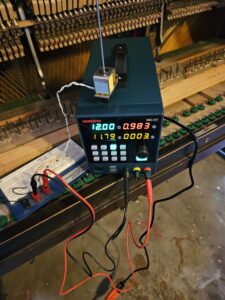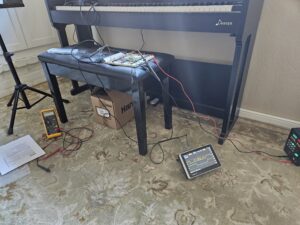Week 2 Blog: Delays
March 10, 2024
So far, this week has been slow. I started out the week with working on designs for a volume control circuit since I had placed several orders over the previous weekend, and they hadn’t arrived yet. Luckily, two of them arrived in the middle of the week and they had enough parts to allow me to continue testing.
One of these packages contained 4 solenoids that someone salvaged from an old first generation Pianodisc Player piano and sold to me on eBay. I got to testing these solenoids right away and found that these solenoids performed significantly better than the other ones I tested, outperforming them in every metric. These new solenoids were significantly more powerful, and had almost twice the push force as the other solenoids, while not drawing ridiculous amounts of current. They also run on 12 volts compared to the 24 volts that some of the other solenoids required, which makes sourcing a power supply for this project significantly easier. These new solenoids are also much more robust, and have stronger mounting hardware, allowing for more stable operation and less noise. The old solenoids also had a problem where they would stick in the extended position for around a second after the power supply was disconnected. These new solenoids do not have this problem which will be important when playing music that has lots of short (staccato) notes. The new solenoids do have one downside though, in that they are significantly bigger, to big to be fit side-by-side in the piano. However, they fix this problem by having long and short solenoids, allowing them to be staggered so that way they can fit within the required space constraints.

Exhibit 1: Fitting short and long solenoids into the piano.
The second package I received contained a MIDI host device as well as a MIDI cable. One of the problems I faced when designing the decoder was the problem of easily generating MIDI signals to test it with. These two devices would allow me to generate MIDI signals using a digital piano that I already have by connecting it to the MIDI Host device using USB and then connecting a MIDI cable between the host device and the input to my decoder circuit. When I press a key on my digital piano, It will send a signal to the decoder circuit with the information about the note press. Although in the future the digital piano will be replaced by a computer reading from a file, the digital piano will allow me to test the circuitry before I have all that set up by simply pressing a key. I connected the circuit after triple checking all of the connections with my multimeter and probed it with my oscilloscope, expecting to see it work, and I got nothing. I tried many different things; playing with settings on my oscilloscope, checking connections, turning it off and on again, all to no avail until after 3 hours of debugging, I realized that one of the microchips was plugged in backwards. Once I discovered this, it was an easy fix and it mostly worked first try after that. (I forgot to ground the “Enable Output” pins on some of the latches I was using, but this issue didn’t take long to find).

Exhibit 2: Solenoid actuating a piano key as I’m holding it.

Exhibit 3 above: One of the new long solenoids extended on top of a power supply.

Exhibit 4: Oscilloscope measuring decoder input signal (yellow) and an output bit signal (blue).
 Exhibit 5: Test setup for decoder circuit.
Exhibit 5: Test setup for decoder circuit.
Overall, even with the delays, I am proud of the progress that I made this week and I hope to have a note or two playing automatically by early next week. (Assuming FedEx doesn’t drop-kick my packages…)

Leave a Reply
You must be logged in to post a comment.